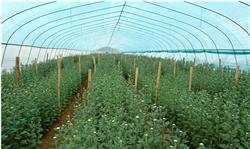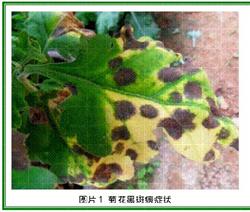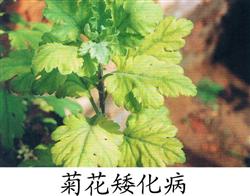Prevention and treatment of root cancer of chrysanthemum

The main results are as follows: 1. damage symptom chrysanthemum root cancer disease mainly occurs at the root neck of the plant or on the lateral roots and branches of the plant, and the diseased part produces tumors of different sizes. At the initial stage, the tumor is grayish brown, the surface is smooth, the texture is not hard, and then it becomes brown, the epidermis is rough or cracked and hardened, resulting in green loss or yellowing of the aboveground parts, small and early fallen leaves, slow growth or death of the diseased plants. 2. The pathogen is Agrobacteriumtumefaciens. It is called Agrobacterium tumefaciens or Agrobacterium tumefaciens, which belongs to bacteria. The bacteria are short rod-shaped, solitary or paired growth, 1.2-3 × 0.4-0.8 (micron) in size, with 1-5 weekly flagella, Gram staining negative, can form a capsule without spores, and grow rapidly on meat peptone Agar medium, the colony is white, round, the edge is neat, bright and translucent. It is cloudy on the liquid medium, and there is a thin film on the surface. Physiological and biochemical performance: non-liquefied gelatin; solidified milk but not condensed; reduced litmus milk turned blue; slightly reduced nitrate; slight acid production on glucose, fructose, arabinose, galactose, mannitol, salicylate, but no gas production; no hydrolyzed starch. The temperature limit for bacterial growth was 0-37 ℃, the optimum temperature was 25-30 ℃, and the lethal temperature was 51 ℃ for 10 minutes. The range of acid and alkali tolerance of bacteria is pH5.7-9.2, and the optimum pH7.3 is. Third, the incidence characteristics of root cancer bacteria overwintering in the cortex of tumor tissue or mixed with soil. Bacteria can survive in the soil for more than a year and spread through Rain Water and irrigation water. In addition, underground pests such as grubs, mole crickets and nematodes can also spread bacteria. Bacteria invade through damage caused by insect injuries, mechanical injuries and other root diseases. After invasion, it is only colonized in the cortical tissue and secretes indole acetic acid in the process of parasitism to stimulate the surrounding cells to accelerate division and increase in volume to form a cancer. After the host cell becomes a cancer, no bacteria can continue to expand. Temperature and humidity are the main conditions for bacterial infection of root cancer. bacterial infection and incidence increase with the increase of soil moisture, and vice versa. The cancer was closely related to temperature. The tumor grew fast and large at 28 ℃, but did not form when it was higher than 31-32 ℃, and formed slowly and small below 26 ℃. Alkaline soil is beneficial to the disease, acidic soil is disadvantageous to the disease, pH6.2-8 can still maintain the pathogenicity of bacteria, and the disease below pH6 is mild or non-pathogenic. Heavy soil viscosity, poor drainage, serious disease; careless farming or underground pests, resulting in wounds, are conducive to the invasion of bacteria and increase the chance of disease. Carrying bacteria in seedlings is the main way of long-distance transmission. Fourth, prevention and control methods (1) strict quarantine, soak the suspected seedlings with 72% agricultural streptomycin sulfate 1500 times solution for half an hour or 1% of 96% copper sulfate for 5 minutes, rinse and then colonize. (2) crop rotation has been carried out for more than 2 years in seriously ill areas. (3) breeding and utilization of disease-resistant varieties. (4) strengthen field management, careful cultivation, avoid all kinds of wounds, find that seriously diseased plants should be removed in time, mild diseased plants can be irrigated with 300,400 times of water or smeared with 72% agricultural streptomycin sulfate soluble powder 1000 times, which has a certain therapeutic effect. If necessary, 50 parts of methanol, 20 parts of glacial acetic acid and 12 parts of iodine tablets are evenly smeared on the surface of the tumor and the surrounding 3cm, which can kill the bacteria on the surface of the tumor. (5) Biological control. It has been reported abroad that a kind of nonpathogenic wild bacilli (Agrobacteriumradiobacter) K84 strain isolated from the roots of cancerous plants can radiate wild bacillus 84 (agrocin84), a nucleotide baculinin, which can effectively inhibit the formation of cancer tissue. Soaking seeds or roots with K84 preparation has a good effect on the prevention and treatment of cancer disease.
- Prev

Control techniques of black spot of chrysanthemum
First, the main symptoms: occur on the leaves, serious can spread to the petiole. The disease spot is gray-black spot in the early stage, surrounded by faded green halo; after expansion, the disease spot is nearly round to irregular, the inside is grayish brown, the edge is dark brown, and there are yellow spots around it; in the later stage, the center of the disease spot is yellow-brown, dry, in a humid environment.
- Next

Three common diseases of chrysanthemum
Chrysanthemum, alias chamomile, is a perennial herbal medicinal plant of Compositae, and traditional Chinese medicine is called white chrysanthemum and yellow chrysanthemum. The flower is used in medicine, which has the effect of soothing wind and heat, clearing liver and eyesight. It is mainly produced in Anhui, Zhejiang, Henan, Hebei and Sichuan and is cultivated in other parts of the country. The main diseases of cultivated chrysanthemum are chrysanthemum powdery mildew,.
Related
- Fuxing push coffee new agricultural production and marketing class: lack of small-scale processing plants
- Jujube rice field leisure farm deep ploughing Yilan for five years to create a space for organic food and play
- Nongyu Farm-A trial of organic papaya for brave women with advanced technology
- Four points for attention in the prevention and control of diseases and insect pests of edible fungi
- How to add nutrient solution to Edible Fungi
- Is there any good way to control edible fungus mites?
- Open Inoculation Technology of Edible Fungi
- Is there any clever way to use fertilizer for edible fungus in winter?
- What agents are used to kill the pathogens of edible fungi in the mushroom shed?
- Rapid drying of Edible Fungi

